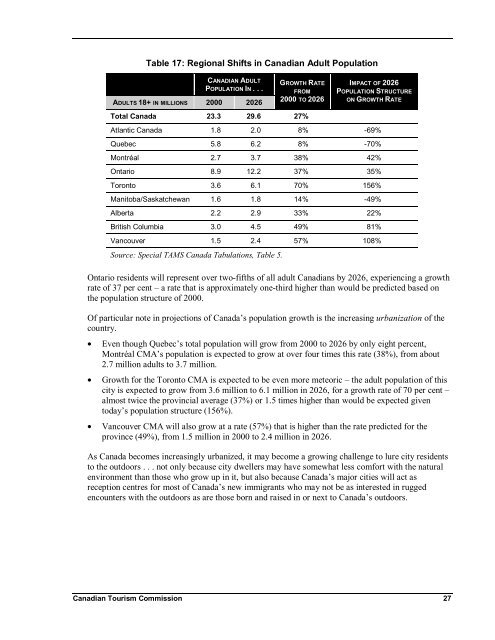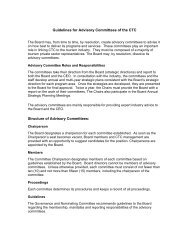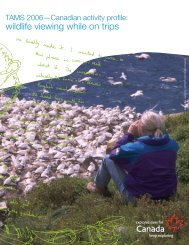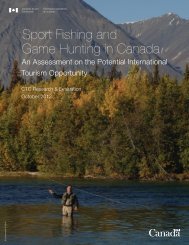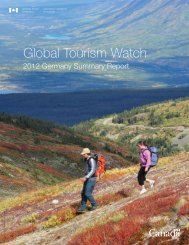Canada's Hard Outdoor Adventure Enthusiasts - Canadian Tourism ...
Canada's Hard Outdoor Adventure Enthusiasts - Canadian Tourism ...
Canada's Hard Outdoor Adventure Enthusiasts - Canadian Tourism ...
You also want an ePaper? Increase the reach of your titles
YUMPU automatically turns print PDFs into web optimized ePapers that Google loves.
Table 17: Regional Shifts in <strong>Canadian</strong> Adult PopulationCANADIAN ADULTPOPULATION IN . . .ADULTS 18+ IN MILLIONS 2000 2026GROWTH RATEFROM2000 TO 2026IMPACT OF 2026POPULATION STRUCTUREON GROWTH RATETotal Canada 23.3 29.6 27%Atlantic Canada 1.8 2.0 8% -69%Quebec 5.8 6.2 8% -70%Montréal 2.7 3.7 38% 42%Ontario 8.9 12.2 37% 35%Toronto 3.6 6.1 70% 156%Manitoba/Saskatchewan 1.6 1.8 14% -49%Alberta 2.2 2.9 33% 22%British Columbia 3.0 4.5 49% 81%Vancouver 1.5 2.4 57% 108%Source: Special TAMS Canada Tabulations, Table 5.Ontario residents will represent over two-fifths of all adult <strong>Canadian</strong>s by 2026, experiencing a growthrate of 37 per cent – a rate that is approximately one-third higher than would be predicted based onthe population structure of 2000.Of particular note in projections of Canada’s population growth is the increasing urbanization of thecountry.• Even though Quebec’s total population will grow from 2000 to 2026 by only eight percent,Montréal CMA’s population is expected to grow at over four times this rate (38%), from about2.7 million adults to 3.7 million.• Growth for the Toronto CMA is expected to be even more meteoric – the adult population of thiscity is expected to grow from 3.6 million to 6.1 million in 2026, for a growth rate of 70 per cent –almost twice the provincial average (37%) or 1.5 times higher than would be expected giventoday’s population structure (156%).• Vancouver CMA will also grow at a rate (57%) that is higher than the rate predicted for theprovince (49%), from 1.5 million in 2000 to 2.4 million in 2026.As Canada becomes increasingly urbanized, it may become a growing challenge to lure city residentsto the outdoors . . . not only because city dwellers may have somewhat less comfort with the naturalenvironment than those who grow up in it, but also because Canada’s major cities will act asreception centres for most of Canada’s new immigrants who may not be as interested in ruggedencounters with the outdoors as are those born and raised in or next to Canada’s outdoors.<strong>Canadian</strong> <strong>Tourism</strong> Commission 27


